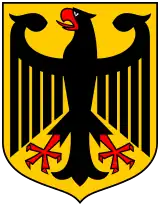Germany–Poland relations
The bilateral relations between Poland and Germany have been marked by an extensive and complicated history.[1]
 | |
Germany |
Poland |
|---|---|
From the 10th century onward, the Piast-ruled Kingdom of Poland established under Duke Mieszko I had close and chequered relations with the Holy Roman Empire. However, these relations were overshadowed in the Late Middle Ages both by the push eastwards of the Margraviate of Brandenburg into Polish territory and the centuries-long Polish–Teutonic Wars, as a result of which the State of the Teutonic Order became a part and fief of the Kingdom of Poland, later transformed with the consent of the Polish King into the secular Duchy of Prussia. Prussia retained a certain level of autonomy under Polish rule. Later, the Kingdom of Prussia rose and eventually became one of the three partitioners of Poland in 1772–1795. Following the partitions various anti-Polish policies were pursued, including the Kulturkampf, Germanization and expulsions of Poles. That period was also marked by several Polish uprisings against Prussian rule, including the Greater Poland uprising of 1848 during the European Revolutions of 1848.
After World War I, in 1918, Poland regained independence and its place on the map. Under the Treaty of Versailles, Poland regained most of the territories lost to Prussia in the Partitions of Poland and parts of territories lost even earlier, while Gdańsk (Danzig) became a free city in customs union with Poland. It was seen as a great injustice in the Weimar Republic, in part leading to the Nazi takeover of power in 1933. On 1 September 1939, Poland was invaded by Germany, thus initiating World War II. The Third Reich established concentration camps in German-occupied Poland, the biggest located in Auschwitz. Poland suffered circa 6 million casualties and huge material damages during the war as Germany sought to carry out genocide on its Polish, Jewish and Roma populations.[2] As a result of World War II and the decision of the Big Three, Poland lost the eastern half of its territory, which was annexed by the Soviet Union, and in return received most of the pre-war eastern territories of Germany, which it had previously lost either in the Partitions of Poland or earlier. In 1945–1950, a series of flights and expulsions happened, in which up to 11 million ethnic Germans were forced to leave their homes in Poland and resettle in post-war West and East Germany. It was the largest forced movement of any population in history.
The Cold War saw good relations between the communist states of People's Republic of Poland and the German Democratic Republic. Polish-West German relations, on the other hand, were strained, although they improved after Chancellor Willy Brandt launched the Ostpolitik. In 1990, Germany reunified and it confirmed the Polish-German border on the Oder-Neisse line in a treaty. Both states are now NATO and the European Union allies and partners, having an open border and being members of the European Single Market. Both countries are also members of the OECD, OSCE, the Council of Europe, the Council of the Baltic Sea States, HELCOM and the World Trade Organization. The once poor relationship between Poland and Germany has now become a strategic partnership.
Overview
Middle Ages

In the 10th century, the West Slavic Polan tribes under the Piast prince Mieszko I about 960 were able to establish a sovereign state around Poznań and Gniezno in an area later called Greater Poland. Mieszko's territory included Masovia beyond the Vistula river, Silesia and in 962/63 he first met with the Saxon forces of Margrave Gero, ruler of the Marca Geronis between the Saale and Bóbr rivers established in 937 by King Otto I of Germany. During the fight with Germanic duchies Mieszko I in 963 recognized Otto I as Emperor[3] In return for tribute to the newly crowned Emperor, Otto I recognized Mieszko I as amicus imperatoris ("Friend of the Emperor") and stated that he is dux Poloniae ("Duke of Poland"). As he could not prevail against Gero, Mieszko I resorted to consolidate his realm: he strengthened the relations with the Bohemian duke Boleslaus I by marrying his daughter Dobrawa and converted to Christianity in 966. The next year however, he once again entangled with the troops of the Saxon renegade Wichmann the Younger, fighting over the island of Wolin on the Baltic coast. He also had to defend the Polish border on the lower Oder river against the forces of Margrave Odo I of Lusatia at the 972 Battle of Cedynia.

Meanwhile, Poland had to face the claims to universal power raised by Otto I when he had conquered the Kingdom of Italy and was crowned Holy Roman Emperor by Pope John XII in 962. According to the idea of the translatio imperii, the Emperor would continue the tradition of the Roman and Carolingian Empire as guardian of the Catholic Church superior to all secular and ecclesiastical rulers. Mieszko sought to improve the relations with Otto I: he appeared as amicus imperatoris at the Imperial Diet of Quedlinburg in 973 and in 978 secondly married Oda, the daughter of Dietrich of Haldensleben, margrave of the Northern March. In 984 Mieszko's son Bolesław I the Brave was married to a daughter of Margrave Rikdag of Meissen. However, in the same year the Polish ruler, instigated by Duke Boleslaus II of Bohemia, interfered in the conflict between minor King Otto III of Germany and the deposed Bavarian duke Henry the Wrangler. He timely switched sides, when he realized that Otto's mother Theophanu would gain the upper hand and in turn sparked a long-term conflict with the Bohemian dukes over Silesia and Lesser Poland. Mieszko backed the German forces several times against the revolting Lutici (Veleti) tribes (though to no avail) and until his death in 992 remained a loyal supporter of the Emperor. Nevertheless, Mieszko precautionally had the Dagome iudex document drawn up, whereby he put his realm called Civitas Schinesghe under the auspices of the Holy See.
A major German–Polish War was fought between 1003 and 1018. In 1109, Poland defeated the invading German forces at Głogów.
Throughout the Middle Ages, the Germans expanded eastwards from modern western and central Germany into the less populated regions, east of Elbe and Saale rivers, which were inhabited by Slavic, Baltic and Finnic peoples, including Poles. The area of German settlement roughly stretched from Slovenia to Estonia, and southwards into Transylvania. The phenomenon, known as "Ostsiedlung" ("east settlement", "settlement in the east") followed the territorial expansion of the Holy Roman Empire and the Teutonic Order. At various times, Germans were also encouraged by Polish rulers of the Piast dynasty to settle in Poland. Ethnic conflicts erupted between the newly arrived settlers and local populations.[4]

In the 13th century, Poland was suffering from the attacks of Pagan tribes. In response, Konrad I of Masovia hired an army of unemployed crusaders - the Teutonic Order. After the failure of converting the Old Prussians to Christianity, the Order fell into a series of conflicts with the Polish state. The Teutonic Knights invaded the Polish coastal region of Gdańsk Pomerania with the country's main port city of Gdańsk,[5] and therefore took the control of the nearly entire southeastern Baltic Sea coast. The Teutonic Knights continued to occupy the region despite papal verdicts.[5] They remained powerful until 1410, when a combined Polish-Lithuanian army was able to win a decisive victory over the Teutonic Order at Grunwald. As a result, Poland emerged as a major power in Central Europe.[6] Already in the 15th century, German theologian and writer John of Falkenberg proposed and advocated the genocide of Poles.[7] After the Battle of Grunwald, he suggested that the Polish nation, including the King, should be exterminated either in its entirety, or in majority, and be also reduced to slavery.[7] After Poland challenged his works at the Council of Constance, his views were condemned by Pope Martin V in 1424.[7] He is considered the first writer to formulate the argument in justification of genocide of another nation.[7] During the Thirteen Years' War (1454–1466), Poland regained the territories previously annexed by the Teutonic Knights, and the remainder of the State of the Teutonic Order also became a part of the Kingdom of Poland as a fief.[8]
Modern Age
In the 16th century, after the Counter-Reformation was launched and the Thirty Years War broke out in the German lands, Poland became a Roman Catholic stronghold. In 1683, the Polish army commanded by Polish king John III Sobieski helped to relieve the siege of Vienna and along with the Holy Roman Empire, ended the growing expansion of the Ottoman Empire into Europe. In the following decades Poland and Bavaria enjoyed good relations, and Bavarian electors Maximilian II Emanuel and Maximilian III Joseph married Polish princesses Theresa Kunegunda Sobieska and Maria Anna Sophia (daughters of Kings John III Sobieski and Augustus III of Poland), respectively.
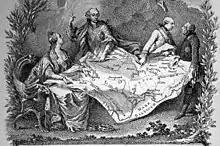
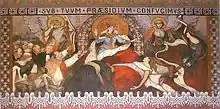
In the second half of the 18th century, the Polish–Lithuanian Commonwealth was partitioned three times between Russian Empire, Kingdom of Prussia and the Habsburg monarchy. The partitions took place in 1772, 1793 and 1795. Under Prussian rule in areas where the Polish population lived alongside Germans a virtual apartheid existed, with bans on the Polish language and religious discrimination, besides attempts to colonize the areas with Germans.[9] Germanisation policies were pursued by Prussia and, since 1871, Germany. Several Polish uprisings broke out, with the largest one being the Greater Poland uprising of 1848. Prussian leader and founder of modern Germany, Otto von Bismarck, in regards to Poles, wrote: Hit the Poles so hard that they despair of their life; I have full sympathy with their condition, but if we want to survive, we can only exterminate them; the wolf, too, cannot help having been created by God as he is, but people shoot him for it if they can.[10] Germany also carried out expulsions of Poles, and since the late 19th century, the Lebensraum concept was proliferated in Germany, and it also pertained to annexed ancient Polish territories. Since the late 19th century, many Poles migrated from the German-controlled Polish areas to work in the industrialized Ruhr region in western Germany and formed a vibrant Polish community known as the Ruhrpolen. It was also subjected to anti-Polish and Germanisation policies. Bernhard von Bülow, who served as Chancellor of Germany from 1900 to 1909, called the Polish victory over the Teutonic Knights at the Battle of Grunwald in 1410 the Germans' most portentous national disaster.[11]
First World War (1914–1918)
During World War I, Germany invaded and occupied vast areas of the Russian Partition of Poland, and in August 1914, the German Army carried out the destruction of Kalisz, one of Poland's oldest historical cities. During the war, the Polish Legions led by Józef Piłsudski initially fought on the side of Austria-Hungary and Germany against Russia, in hope of defeating at least one of the partitioning powers and restoring independent Poland at least in the former Russian Partition. Moreover, just before the outbreak of the war, some 40,000 Poles served in the Imperial German Army, and during the war the number of such conscripts rose to 850,000.[12] Polish military units were also formed in Russia (Polish Armed Forces in the East) and France (Blue Army), enemies of Germany. Germany ran special prisoner-of-war camps for captured ethnic Poles from the Russian Army, with the aim of subjecting them to propaganda and conscripting them into a planned German-controlled Polish army to fight against Russia.[13] Faced with the mass reluctance and distrust from the Polish POWs, the plan failed and was abandoned.[14]
Per the Act of 5th November, Germany and Austria-Hungary proclaimed the Regency Kingdom of Poland, a German-controlled puppet state. It was formed in the western part of the former Russian Partition and did not include the more north-eastern German-occupied areas of the Russian Partition, which were instead administered by the Germans as the Ober Ost. Moreover, Germany still planned the annexation of the so-called "Polish Border Strip" and expulsion of up to 3 million of its Polish inhabitants (including Polish Jews) to make room for German colonization in accordance with the Lebensraum policy.
Following the Oath crisis, in July 1917, the Germans arrested Józef Piłsudski and his close associate Kazimierz Sosnkowski and then imprisoned them in Magdeburg.[15] Near the end of the war, the Germans offered to release them in exchange for Piłsudski's declaration of loyalty to Germany, but Piłsudski declined.[15] Nevertheless, Piłsudski and Sosnkowski were eventually released on November 8, 1918, after the outbreak of the German Revolution of 1918–1919.[15] Three days later, Germany signed the Armistice of 11 November 1918 with the Allies, and Piłsudski proclaimed the independence of Poland. That day, during his speech in Warsaw, he declared that the Polish nation did not want revenge against the Germans for past wrongdoings.[15]
Interbellum (1918–1939)
.jpg.webp)
After Poland regained independence in 1918, it sought to regain its former western regions, and the Polish Greater Poland uprising of 1918–19 and Silesian Uprisings against Germany broke out in the disputed regions of Greater Poland and Upper Silesia. Eventually, Poland regained the majority of the lands lost to Prussia in the Partitions of Poland, and parts of the territories lost even earlier, including the industrialized part of Upper Silesia in 1922. Germany remained hostile to Poland and refused to regard the German-Polish border as permanent nor even Poland's independence itself. Already in 1922, Chief of the German Army Hans von Seeckt stated: Poland's existence is intolerable and incompatible with the essential conditions of Germany's life. Poland must go and will go - as a result of her internal weakness and of action by Russia - with our aid.[16]
A German–Polish customs war began in 1925, but in 1934 Nazi Germany and Poland signed the German–Polish declaration of non-aggression. A trade agreement followed.
Two conferences addressed the matter of the school history-books used in Poland and in Germany:[17]
In the late 1930s, before the German-Soviet invasion of Poland, which started World War II, discrimination and persecution of the Polish minority in Germany, including the indigenous Poles in the territories that remained within Germany in the interbellum, intensified.[18] Germany carried out mass arrests, expulsions, deportations to concentration camps and assassinations of local Polish leaders, activists and prominent individuals.[18] There were numerous cases of attacks on Polish property, schools, printing houses, many Polish organizations were seized, Polish press and culture centers were closed down, Polish church services were banned.[18][19] Germany carried out extensive anti-Polish propaganda, and increased censorship and confiscations of Polish press and publications.
In October 1938 Germany expelled about 17,000 Polish Jews to Poland in the Polenaktion.
On August 23, 1939, the Molotov–Ribbentrop Pact was signed by Germany and the Soviet Union, which included the Secret Protocol, which divided Central and Eastern Europe, including Poland, between the two invaders. In the following days, there were several German provocations at the Polish-German border,[20] and on August 25–26, 1939 the German Abwehr attacked a Polish train station near the Polish-Slovak border, but it was repelled by the Polish Army (see Jabłonków incident). On August 28, 1939, a German saboteur carried out a train station bombing in Tarnów in southern Poland, killing 20 people and wounding 35 others. On August 31, 1939, Germany staged the Gleiwitz incident, a false flag attack which was to serve as a casus belli to justify the invasion of Poland, which started the next morning,[20] without a declaration of war.
Second World War (1939–1945)
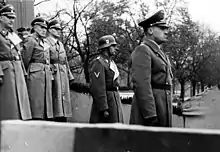
In September 1939 Nazi Germany invaded Poland and partitioned the country together with the Soviet Union, and then occupied its western half. The western and northern portion of this territory was directly annexed to Germany, while in the remainder the General Government was formed.
Nazi Germany's Directive No. 1306 stated that Polishness equals subhumanity. Poles, Jews and gypsies are on the same inferior level,[21] and the Polish population was subjected to extensive genocidal policies, including large massacres, mass expulsions, roundups, arrests, incarceration, kidnapping of Polish children, kidnapping of Polish girls and women for sexual slavery, pacification actions, extermination of mentally ill people and deportations to forced labour and concentration camps, some of which were established in occupied Polish territory (including Auschwitz, Soldau, Majdanek). The Intelligenzaktion, which was launched instantly during the invasion of Poland, was the first genocidal campaign carried out by Nazi Germany.[22] It targeted the Polish intelligentsia and Poles engaged in various activities,[22] who were considered capable of organising or leading a Polish resistance movement, which was formed and was active throughout the war regardless. The campaign was then continued from 1940 as the AB-Aktion. Over 2.8 million Poles, including women and children, were deported to slave labour, and Poles accounted for 60% of all foreign slave workers in Germany.[23] In March 1940, Germany issued the racist and repressive Polish decrees, which regulated the working and living conditions of Polish slave workers.[24][25] Polish slave workers were obliged to wear "P" badges and were subjected to strict segregation policies, with certain activities, such as sexual intercourse with German people, being punishable by deportation to concentration camps or death.[24][26] Germany also extensively looted Poland of its cultural and industrial possession and vandalized its heritage. The Catholic Church in Poland was brutally persecuted. Countless prisons and forced labour camps and several major prisoner-of-war camps were established and operated by Germany in occupied Poland. In 1941 Adolf Hitler launched Operation Barbarossa, attacking the Soviet Union, after which Germany also occupied the eastern half of Poland, in which it continued the extermination of Poles, with prime examples including the massacre of Lwów professors and Ponary massacre. Polish Jews were among the primary victims of the German-perpetrated Holocaust, and rescuing and helping Jews by Poles was punishable by death, not only for the rescuers, but also their entire families. The imposition of such extreme measures was unique to Poland among all of German-occupied Europe.
.png.webp)
During the war, Poles as one of the Allies of World War II fought against Germany on various war fronts, including the Norwegian campaign, Battle of France, Battle of Britain,[27] the North African campaign, Operation Jubilee, the Italian campaign (including the victorious Battle of Monte Cassino), the Vistula–Oder Offensive and the Western Allied invasion of Germany.
The Polish resistance movement, including the Home Army and the Polish Underground State, was the largest underground resistance movement in all of German-occupied Europe.[23] Poland did not establish a collaborationist government under German occupation,[23] and pre-war Polish Prime Minister Kazimierz Bartel was even murdered by the Germans for refusing to form one.[28] Several Polish uprisings against Germany broke out, including the Zamość uprising, Iwieniec Uprising, Operation Ostra Brama, Lwów uprising and the Warsaw Uprising. During the latter, SS chief Heinrich Himmler anticipated a total destruction of Warsaw, the capital of the former Polish nation, which has supposedly blocked the Germans' road to the east for 700 years.[29] Following the Polish loss in the uprising, Germany carried out the planned destruction of Warsaw in late 1944, and in October 1944, Himmler stated in regards to Warsaw: The city must completely disappear from the surface of the earth and serve only as a transport station for the Wehrmacht. No stone can remain standing. Every building must be razed to its foundation.[29]
Following the Operation Barbarossa, the Germans and German-held Polish forced laborers discovered the mass graves of over 4,000 Polish officers and intelligentsia murdered in the Katyn Forest by the Soviet Union in 1940. In April 1943, Germany exposed the crime, now known as the Katyn massacre, to the world. The Germans allowed the International Red Cross and Polish Red Cross to the site, and formed the International Katyn Commission to investigate the massacre.
In 1943 Stalin demanded at the Tehran Conference that the post-war territory of Germany and Poland be redrawn further west as a buffer between Soviet Union and Germany.
Nazi Germany killed nearly 6 million Polish citizens,[30][31] including Polish academics, doctors, lawyers, nobility, priests and others. Poland suffered the largest destruction among all German-occupied countries during World War II.[29]
Following the defeat of Germany in 1945, this policy exercised by the Germans would lead to anti-German sentiment among the oppressed Poles which would reflect in the expulsion of Germans from the territories assigned to Poland.
Cold War (1945–1969)
East Germany |
Poland |
|---|---|
During the Cold War, East Germany shared the fate of Poland, which fell into the Soviet sphere of influence, and both countries had Soviet-installed communist regimes, and therefore enjoyed good relations. In 1950, both countries signed the Treaty of Zgorzelec, which officially confirmed and recognized the Polish-East German border. On the other hand, during the early Cold War, Poland–West Germany relations were strained.
Ostpolitik (1970–1989)
The relations between West Germany and Poland improved through Willy Brandt's Ostpolitik. West Germany recognized the Oder-Neisse line as Poland's western border in the Treaty of Warsaw. The Warschauer Kniefall gesture by Chancellor and future Nobel Peace Prize laureate Willy Brandt, which took place at the Monument to the Warsaw Ghetto Uprising Heroes in 1970, was regarded as a major step in the process of reconciliation between the two countries.[32]
From 1972 to 1980, Poland and East Germany enjoyed visa-free travel. Due to large anti-communist protests and the emergence of the Solidarity movement in Poland, East Germany unilaterally terminated the visa-free travel agreement and closed the border.
From the fall of Communism to accession (1989–2004)
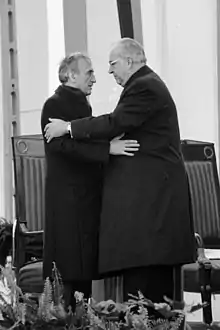
After the fall of communism, Poland and the reunited Germany have had a somewhat positive, but occasionally strained relationship due to sensitive political issues. In March 1990, German chancellor Helmut Kohl caused a diplomatic firestorm when he suggested that a reunified Germany would not accept the Oder–Neisse line, and implied that the Federal Republic might wish to restore the frontier of 1937, by force if necessary.[33] After the statement caused a major international backlash that threatened to halt German reunification, Kohl retracted his comments after knuckling under international rebuke, and assured both the United States and the Soviet Union that a reunified Germany would accept the Oder–Neisse line as the final border between Poland and Germany.[34]
In the 1990s, Germany opposed Poland joining NATO, according to archived German Foreign Ministry files released in 2022.[35] Germany, pursuing a pro-Russian policy, tried to discourage Poland from joining NATO during confidential discussions, and tried to convince other member countries against Poland's NATO membership.[35] Poland eventually joined NATO in 1999.
Poland, Germany and France are part of the Weimar Triangle which was created in 1991 to strengthen cooperation between the three countries.[36]
In the 1990s, some reparations from World War II were continued to be repaid to Poland and that money was distributed through the Foundation for Polish-German Reconciliation, a foundation supported by both governments.
The Polish-German border is 467 km long.[37]
Following accession to the European Union (2004–present)

German–Polish relations are sometimes strained when topics like World War II and the postwar forced expulsion of the German citizens from the territories assigned to Poland are brought up.[38] Occasional xenophobic statements by politicians on both sides, most notably Erika Steinbach[39] and Jarosław Kaczyński,[40][41][42] have slowed the improvement of the relations.
Polish firefighters helped in flood recovery in Germany during the 2002[43] and 2021 floods,[44] and helped extinguish wildfires in 2019.[45]
In 2007, Poland joined the Schengen Area, and passport-free and visa-free travel between Germany and Poland is allowed since.
.jpg.webp)
On 24 September 2013 Lech Wałęsa suggested the creation of a political union between the Republic of Poland and the Federal Republic of Germany; his reason was that the borders in Europe don't matter anymore and in the future they will change anyway.[46]
Poland and Germany have held intergovernmental consultations to discuss the political and economic cooperation between the two countries on a number of occasions in the past. In 2018, Polish Foreign Minister Jacek Czaputowicz and his German counterpart Heiko Maas agreed a to pass a declaration specifying the strategic priorities for German-Polish cooperation which stated that "both countries support a multilateral, rules-based order and champion a united Europe".[47]
In 2020, Poland surpassed Italy to become Germany's fifth biggest trading partner[48] as well as the biggest one in East-Central Europe.[49]
On 15 September 2021, the German Foreign Minister Heiko Maas announced a project to build a monument commemorating the Polish civilian victims of World War II in Berlin that would "honour their lives, their resistance and their courage". He also revealed plans to establish a forum for remembrance and exchange with Poland stating that "The future forum [...] could become a milestone for German-Polish reconciliation. For addressing the past is not something we only owe to the dead. For Germans and Poles it remains the basis of our common path towards the future".[50]
To help combat the COVID-19 pandemic, Poland sold some 6.5 million COVID-19 vaccines to Germany.[51]
World War II reparations
On 1 September 2022, Poland's government headed by Prime Minister Mateusz Morawiecki presented to the public a three volume report detailing war damages caused by the German occupation of Poland between 1939 and 1945. The report, which covered both human and material loses, placed the value of wartime damages caused by the German occupation at $1.3 trillion.[52] The report also addressed the issue of post-war reparations stating that apart from the 1953 non-binding resolution made by the then communist government led by Bolesław Bierut under pressure from the Soviet Union, no official diplomatic steps were made to settle the issue of wartime reparations, and no formal diplomatic note was ever presented to the East German government informing it of Poland's intentions to renounce its reparation rights.[53][54]
On 2 October 2022, the Polish Foreign Minister Zbigniew Rau signed a formal diplomatic note asking Germany to start an official negotiations process, and on 3 October 2022 presented the diplomatic note to the visiting German Foreign Minister Annalena Baerbock.[52]
Earlier in December 2021, German Chancellor Olaf Scholz rejected the idea of paying further World War II reparations to Poland.[55] According to the German government, there is no legal basis for further compensation payments.[56] The Polish government rejects this view, stating that the then Polish communist government was under the sway of the Soviet Union and that its 1954 refusal is non-binding.[57]
As a consequence of aggression by Nazi Germany, Poland lost about a fifth of its population and much of Poland was subjected to enormous destruction of its industry and infrastructure.[58][59]
Resident diplomatic missions
Polish diplomatic missions in Germany
Poland has an embassy in Berlin and consulates-general in Cologne, Hamburg and Munich.[60]
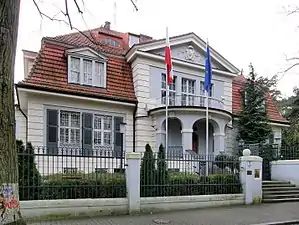 Embassy of Poland in Berlin
Embassy of Poland in Berlin Consulate-General of Poland in Cologne
Consulate-General of Poland in Cologne.ajb.jpg.webp) Consulate-General of Poland in Hamburg
Consulate-General of Poland in Hamburg Consulate-General of Poland in Munich
Consulate-General of Poland in Munich
German diplomatic missions in Poland
Germany has an embassy in Warsaw and consulates-general in Gdańsk, Kraków and Wrocław and a consulate in Opole.[61]
 Embassy of Germany in Warsaw
Embassy of Germany in Warsaw.JPG.webp) Consulate-General of Germany in Gdańsk
Consulate-General of Germany in Gdańsk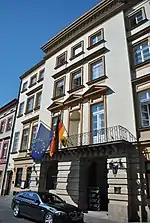 Consulate-General of Germany in Kraków
Consulate-General of Germany in Kraków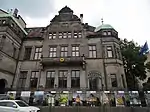 Consulate-General of Germany in Wrocław
Consulate-General of Germany in Wrocław Consulate of Germany in Opole
Consulate of Germany in Opole
See also
- Poles in Germany
- German minority in Poland
- German–Polish Border Treaty, 1990; now in effect
- German–Polish declaration of non-aggression, 1934
- List of twin towns and sister cities in Germany
- List of twin towns and sister cities in Poland
- Poland in the European Union
- Germany–Poland border
- Weimar Triangle
Notes and references
- German-Polish Relations: A History Of Betrayals
- Snyder, Timothy (5 October 2010). "The fatal fact of the Nazi-Soviet pact". The Guardian.
When the Germans shot tens of thousands of Poles in 1944, with the intention of making sure that Warsaw would never rise again, that was genocide, too. Far less dramatic measures, such as the kidnapping and Germanisation of Polish children, were also, by the legal definition, genocide
- Reuter, 164. Howorth, 226.
- The Germans and the East Charles W. Ingrao, Franz A. J. Szabo, Jan Piskorski Medieval Colonization in Europe, page 31, Purdue University Press,2007
- "wojny polsko-krzyżackie". Encyklopedia PWN (in Polish). Retrieved 1 January 2021.
- Ekdahl, Sven (2008), "The Battle of Tannenberg-Grunwald-Žalgiris (1410) as reflected in Twentieth-Century monuments", in Victor Mallia-Milanes (ed.), The Military Orders: History and Heritage, vol. 3, Ashgate Publishing, Ltd., p. 175, ISBN 978-0-7546-6290-7
- Cassar, John (1997). "The Rights of Nations: Reflections on the Address of Pope John Paul II to the 50th Session of the United Nations General Assembly". Center for Global Education, St. John's University. Archived from the original on 22 August 2006.
- Górski, Karol (1949). Związek Pruski i poddanie się Prus Polsce: zbiór tekstów źródłowych (in Polish and Latin). Poznań: Instytut Zachodni. pp. 88–92, 96–97, 206–210, 214–215.
- A history of modern Germany, 1800-2000 Martin Kitchen Wiley-Blackwel 2006, page 130)
- Holborn, Hajo. A History of Modern Germany: 1840-1945. Vol. 3. Taylor & Francis. p. 165.
- von Bülow, Bernhard (1914). Imperial Germany. Translated by Lewenz, Marie A. New York: Dodd, Mead and Company. p. 300.
- Stanek, Piotr (2017). "Niemieckie obozy jenieckie dla Polaków z armii rosyjskiej w latach I wojny światowej (1916–1918)". Łambinowicki rocznik muzealny (in Polish). Opole. 40: 43. ISSN 0137-5199.
- Stanek, p. 45
- Stanek, p. 66
- Kowalski, Waldemar. "Józef Piłsudski w Magdeburgu, czyli więzień stanu nr 1". dzieje.pl (in Polish). Retrieved 13 March 2021.
- "Poland and Germany". The Irish Times. Retrieved 11 March 2023.
- Germany Turns Eastward by Michael Burleigh, Cambridge University Press, 1988.
- Cygański, Mirosław (1984). "Hitlerowskie prześladowania przywódców i aktywu Związków Polaków w Niemczech w latach 1939-1945". Przegląd Zachodni (in Polish) (4): 23.
- Wardzyńska, Maria (2003). ""Intelligenzaktion" na Warmii, Mazurach i północnym Mazowszu". Biuletyn Instytutu Pamięci Narodowej (in Polish). No. 12-1 (35-36). IPN. p. 39. ISSN 1641-9561.
- Roy Godson; James J. Wirtz (2011). Strategic Denial and Deception: The Twenty-First Century Challenge. Transaction Publishers. p. 100. ISBN 978-1-4128-3520-6. Retrieved 20 March 2021.
- Dick, Sheldon (1997). Wegner, Bernd (ed.). From Peace to War: Germany, Soviet Russia, and the World, 1939-1941. p. 50.
- Wardzyńska, p. 38
- Wituska, Krystyna (2006). Tomaszewski, Irene (ed.). Inside a Gestapo Prison: The Letters of Krystyna Wituska, 1942–1944. Detroit: Wayne State University Press. p. xxi.
- "Dobrzy Niemcy, źli Niemcy. Robotnicy przymusowi z Polski i ich relacje z Niemcami". zwangsarbeit-archiv.de (in Polish). 21 January 2015. Retrieved 20 March 2021.
- Ulrich Herbert (1997). Hitler's Foreign Workers: Enforced Foreign Labor in Germany Under the Third Reich. Translated by William Templer. Cambridge University Press. p. 71. ISBN 978-0-521-47000-1. Retrieved 20 March 2021.
- Herbert, p. 70
- Gasior, Mariusz. "The Polish Pilots Who Flew In The Battle Of Britain". Imperial War Museum. Retrieved 14 February 2021.
- Allen, Arthur (21 July 2014). The Fantastic Laboratory of Dr. Weigl: How Two Brave Scientists Battled Typhus and Sabotaged the Nazis. W. W. Norton & Company. ISBN 9780393244014.
- Wituska, p. xxii
- Materski & Szarota (2009) Quote: Liczba Żydów i Polaków żydowskiego pochodzenia, obywateli II Rzeczypospolitej, zamordowanych przez Niemców sięga 2,7- 2,9 mln osób. Translation: The number of Jewish victims is estimated at 2,9 million. This was about 90% of the 3.3 million Jews living in prewar Poland. Source: IPN.
- Materski & Szarota (2009) Quote: Łączne straty śmiertelne ludności polskiej pod okupacją niemiecką oblicza się obecnie na ok. 2 770 000. Translation: Current estimate is roughly 2,770,000 victims of German occupation. This was 11.3% of the 24.4 million ethnic Poles in prewar Poland.
- The Nobel Peace Prize 1971 Presentation Speech (from the Nobel Prize website)
- Merkl, Peter H. German Unification in the European Context University Park: Penn State Press, 2010 page 132.
- "Kohl Retreats, Says He Accepts Polish Borders". Los Angeles Times. 7 March 1990.
- "Bonn-Moscow Ties: Newly Released Documents Shed Fresh Light on NATO's Eastward Expansion". Spiegel International. 3 May 2022. Retrieved 3 September 2022.
- "The Weimar Triangle: Over 30 years of cross-border cooperation between Germany, France and Poland". auswaertiges-amt.de. 4 March 2022. Retrieved 14 June 2023.
- (in Polish) Informacje o Polsce - informacje ogólne Archived 25 June 2009 at the Wayback Machine. Page gives Polish PWN Encyklopedia as reference.
- Jorunn Sem Fure, Department of History, University of Bergen, "The German-Polish Border Region. A Case of Regional Integration?"
- "Return of xenophobia?". Deccan Herald. 28 September 2010.
- "Jarostaw Kaczynski: German domination is the road to crisis and misery".
- "War reparations. Jaroslaw Kaczynski: Germany must suffer heavy reputational damage".
- "Law and Justice party leader strong on Germans. 'They have humiliated our nation. They have to pay.'". 4 December 2022.
- "Polscy strażacy pomogą w walce ze skutkami powodzi w Niemczech" (in Polish). 16 August 2002. Retrieved 3 September 2022.
- "Polscy strażacy w Niemczech. "Chcemy pomóc naszym sąsiadom"". Polsat News (in Polish). 27 July 2021. Retrieved 3 September 2022.
- "Pożar lasów przy polskiej granicy. Niemcy poprosili o pomoc". TVP Info (in Polish). 27 June 2019. Retrieved 3 September 2022.
- Poland and Germany should unite, says Lech Wałęsa, The Daily Telegraph
- "Working with Poland for a strong and united Europe". Retrieved 15 September 2021.
- "Poland overtakes Italy in trade with Germany - ministry". Retrieved 15 September 2021.
- "Poland is Germany's biggest trade partner in Central-Eastern Europe". Retrieved 15 September 2021.
- "Monument to Polish WWII victims to be erected in Berlin – dep FM". Retrieved 15 September 2021.
- "Polska sprzeda Niemcom jeszcze prawie 3,5 miliona dawek szczepionki przeciw Covid-19". Polska Agencja Prasowa (in Polish). 20 December 2021. Retrieved 11 March 2023.
- "Poland demands $1.3 trillion in World War II reparations from Germany". PBS NewsHour. 3 October 2022. Retrieved 17 October 2022.
- "Członek Rady ISW: zrzeczenie się reparacji w 1953 r. — wątpliwe prawnie". Polska Agencia Prasowa. 2 September 2022. Retrieved 20 October 2022.
"there is no diplomatic note to the government of the GDR, [and] there is no return note"
- "Mularczyk: Nie ma dokumentu spełniającego formalne wymogi uchwały rządu z 1953 r. o zrzeczeniu się reparacji". Bankier.pl. 3 September 2022. Retrieved 20 October 2022.
"There is no document that would meet the formal requirements of the Resolution of the Council of Ministers of 23 August 1953 on the renunciation of war reparations by the People's Republic of Poland – emphasized the PiS MP Arkadiusz Mularczyk, chairman of the council of the Jan Karski Institute of War Losses."
- "New Chancellor Meets Old Resentments. Polish PM Receives Olaf Scholz in Warsaw, Talks of War Reparations and a "Europe of Sovereign States"". Gazeta Wyborcza. 13 December 2021.
- "Leaders of Poland, Germany call for 'swift' solution to Warsaw's rule of law row with EU". Politico. 13 December 2021.
- "Poland upholds WWII reparation claims from Germany - DPA". The First News. 26 November 2021.
- "Poland's ruling party picks a fight with Germany". The Economist. 17 August 2021.
- WELT, DIE (2 August 2017). "Zweiter Weltkrieg: Polens Regierung prüft Reparationsforderungen an Deutschland". DIE WELT.
- Embassy of Poland in Germany (in German and Polish)
- Embassy of Germany in Poland (in German and Polish)
Works cited
- Materski, Wojciech; Szarota, Tomasz (2009). Poland 1939–1945. Casualties and the victims of repressions under the Nazi and the Soviet occupations [Polska 1939–1945. Straty osobowe i ofiary represji pod dwiema okupacjami]. Hardcover, 353 pages. ISBN 978-83-7629-067-6. With a Foreword by Janusz Kurtyka (IPN); and expert contributions by Waldemar Grabowski, Franciszek Piper, and Andrzej Krzysztof Kunert. Archived from the original on 31 March 2012.
{{cite book}}:|work=ignored (help)
Further reading
- Allen, Debra J. The Oder-Neisse Line: The United States, Poland, and Germany in the Cold War (2003) online
- Anderson, Sheldon. A Cold War in the Soviet Bloc: Polish-East German Relations: 1945-1962 (2000) online
- Ciechanowski, Jean. "German-Polish Relations." International Affairs Vol. 12, No. 3 (May 1933), pp. 344–366, JSTOR
- Davies, Norman. God's Playground A History of Poland: Volume II: 1795 to the Present (Oxford University Press. 2005)
- Harris, Kimberly. German-Polish Relations, IHJR
- Korbel, Josef. Poland Between East and West: Soviet and German Diplomacy Toward Poland, 1919-1933 (Princeton UP, 2015).
- Kulski, W.W. Germany and Poland: From War to Peaceful Relations (1976)
- Lukowski, Jerzy. The partitions of Poland 1772, 1793, 1795 (Routledge, 2014).
- Harold von Riekhoff, "German-Polish Relations, 1918-1933", Slavic Review, Vol. 31, No. 4 (Dec., 1972), pp. 917–918
- Reuter, Timothy, The New Cambridge Medieval History, Vol. III: c. 900-c. 1024, Cambridge University Press, 2000
- Zaborowski, Marcin. Germany, Poland, and Europe: Conflict, Co-operation, and Europeanization (Manchester UP, 2004).
Primary sources
- Great Britain. Foreign Office. The British War Blue Book: Miscellaneous No. 9 (1939) Documents concerning German-polish Relations and the Outbreak of Hostilities between Great Britain and Germany on September 3, 1939 (1939) online
External links
 Media related to Relations of Germany and Poland at Wikimedia Commons
Media related to Relations of Germany and Poland at Wikimedia Commons- German-Polish relations: A History Of Betrayals, Spiegel Online, 18 June 2007
- Timeline: War and Peace in German-Polish Relations, Deutsche Welle, 23 August 2006
- Article from Der Spiegel 31/10.2006 on Polish–German Relations, in English
